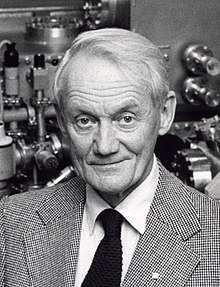Kai Siegbahn
Kai Manne Börje Siegbahn (20 April 1918 – 20 July 2007) was a Swedish physicist.[1]
Kai Siegbahn | |
|---|---|
 Siegbahn in 1981 | |
| Born | 20 April 1918 |
| Died | 20 July 2007 (aged 89) Ängelholm, Sweden |
| Nationality | Sweden |
| Alma mater | University of Stockholm |
| Known for | high-resolution electron spectroscopy |
| Awards | Björkénska priset (1955, 1977) Nobel Prize in Physics(1981) |
| Scientific career | |
| Fields | Physics |
| Institutions | University of Stockholm University of Uppsala |
Biography
Siegbahn was born in Lund, Sweden, son of Manne Siegbahn the 1924 physics Nobel Prize winner. Siegbahn earned his doctorate at the University of Stockholm in 1944. He was professor at the Royal Institute of Technology 1951–1954, and then professor of experimental physics at Uppsala University 1954–1984, which was the same chair his father had held. He shared the 1981 Nobel Prize in Physics with Nicolaas Bloembergen and Arthur Schawlow for their work in laser spectroscopy.[2]
Siegbahn obtained the Nobel Prize for developing the method of Electron Spectroscopy for Chemical Analysis (ESCA), now usually described as X-ray photoelectron spectroscopy (XPS). At the time of his death he was still active as a scientist at the Ångström Laboratory at Uppsala University.
Publications
Kai Siegbahn was one of the original editors of the Encyclopedia of Analytical Chemistry
References
- Jeremy Pearce (August 7, 2007). "Kai Siegbahn, Swedish Physicist, Dies at 89". New York Times. Retrieved 2007-07-21.
- Hagstrom, Stig B. (November 2007). "Obituary: Kai Manne Börje Siegbahn". Physics Today. 60 (11): 74–75. Bibcode:2007PhT....60k..74H. doi:10.1063/1.2812132.
External links
- Kai Siegbahn on Nobelprize.org including the Nobel Lecture, December 8, 1981 Electron Spectroscopy for Atoms, Molecules and Condensed Matter
